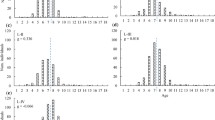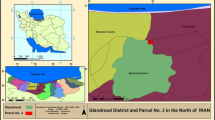Abstract
The aim of this work was to study the effects of gap size and age on natural regeneration of endangered tree species Picea mongolica W. D. Xu, which is only found in the semi-arid region of Northern China. For this purpose, six random transect belts of varying size were established in Baiyinaobao Natural Reserve. The number, height and age of P. mongolica saplings were inventoried. Results show that the total number of saplings per hectare and corresponding number and relative share of saplings in height class I (0.1–0.99 m) decreased along with increasing gap size, opposite to height class III (6–9 m). In height class II (1–5.99 m) the number of saplings per hectare and their relative share increased first slightly and then decreased with the increase of gap size. The number of saplings and their relative share in each height class changed similarly with the increase in the distance to the edge of the mature stand (p < 0.05). Gap age also significantly affect the number of saplings per hectare or their height distribution except in height class II. The distance to the mature stand edge played a very important role in the success of natural regeneration for species P. mongolica.





Similar content being viewed by others
References
Albanesi E, Gugliotta OI, Mercurio I et al (2008) Effects of gap size and within-gap position on saplings establishment in silver fir stands. iFor Biogeosci For 1:55–59
Bullock JM (2000) Gaps and sapling colonization. In: Fenner M (ed) Seeds: the ecology of regeneration in plant communities. CABI Publishing, Walling-ford, pp 375–395
Christopher RW, Craig GL (2005) Minimum opening sizes for canopy recruitment of mid-tolerant tree species: a retrospective approach. Ecol Appl 15(4):1245–1262
Clinton BD, Lindsay RB (1994) Regeneration patterns in canopy gaps of mixed-oak forests of the southern Appalachians: influences of topographic position and evergreen understory. Am Midl Nat 132:308–319
De Chantal M, Leinonen K, Kuuluvainen T et al (2003) Early response of Pinus sylvestris and Picea abies seedlings to an experimental canopy gap in a boreal spruce forest. For Ecol Manag 176(1–3):321–336
Drobyshev IV (1999) Regeneration of Norway spruce in canopy gaps in Sphagnum-Myrtillus old-growth forests. For Ecol Manag 115:71–83
Fritts HC (1976) Tree rings and climate. Academic Press, London
Gagnon JL, Jokela EJ, Moser WK et al (2004) Characteristics of gaps and natural regeneration in mature longleaf pine flatwoods ecosystems. For Ecol Manag 187:373–380
Heuberger K, Fredericksen T, Toledo M, Urquieta W, Ramirez F (2002) Mechanical cleaning and prescribed burning for recruiting commercial tree regeneration in a Bolivian dry forest. New For 24:183–194
Holmes RL (1983) Computer assisted quality control in tree ring dating and measurement. Tree-Ring Bull 43:69–78
Indra PS, Per CO (2009) Gap characteristics and their effects on regeneration, dominance and early growth of woody species. J Plant Ecol 2(1):21–29
John W, McCarthy GordonW (2006) Age and size structure of gap-dynamic, old-growth boreal forest stands in New found land. Silva Fenn 40(2):209–230
Kirchner K, Kathke S, Bruelheide H (2011) The interaction of gap age and microsite for herb layer species in a near natural spruce forest. J Veg Sci 22:85–95
Li XG, He WM, Dong M (1997) A preliminary study on gap dynamics of Gordonia acuminata population in Jinyun Mountain. Acta Ecol Sin 17:543–548 (in Chinese)
Liu Q, Wu Y (2002) Effects of gap size on regeneration of subalpine coniferous forests in northwest Yunnan. Chin J Appl Environ Biol 8(5):453–459 (in Chinese)
Ma ZJ, Fang WQ, Gao QH (1994) Chinese major natural disaster and solution. Scientific Publishing House, Beijing
McGuire JP, Mitchell RJ, Moser EB et al (2001) Gaps in a gappy forest: plant resources, longleaf pine regeneration, and understory response to tree removal in longleaf pine savannas. Can J For Res 31:765–778
Morrissey RC, Jacobs DF, Davis AS, Rathfon RA (2010) Survival and competitiveness of Quercus rubra regeneration associated with planting stocktype and harvest opening intensity. New For 40:273–287
Myers GP, Newton A, Melgarejo O (2000) The influence of canopy gap size on natural regeneration of Brazil nut (Bertholletia excelsa) in Bolivia. For Ecol Manag 127:119–128
Naaf T, Wulf M (2007) Effects of gap size, light and herbivory on the herb layer vegetation in European beech forest gaps. For Ecol Manag 244:141–149
Runkle JR (1990) Gap dynamics in an Ohio Acer-Fagus forest and speculations on the geography of disturbance. Can J For Res 20:632–641
Schnitzer SA, Carson WP (2001) Treefall gaps and the maintenance of species diversity in a tropical forest. Ecology 82:913–919
Timo K (1994) Gap disturbance, ground microtopography, and the regeneration dynamics of boreal coniferous forests in Finland: a review. Ann Zool Fennici 31:35–51
Xu WD, Zou CJ (1998) Chinese sandy forest ecosystem [M]. China Forestry Pub. House, Beijing (in Chinese)
Xu WD, Zheng YR, Liu GT (1993) Relationship between growth and ecological conditions of spruce in sandy land. Chin J Appl Ecol 4(4):368–373 (in Chinese)
Xu WD, Liu GT, Duan PS et al (1998) Study on Picea mongolica forest ecosystem in Baiyinaobao Natural Reserve. Inner Mongolia. China Forestry Pub House (in Chinese), pp 54–72
Yamamoto S (2000) Forest gap dynamics and tree regeneration. J For Res 5:223–229
Zou CJ, Xu WD, Qi SY et al (2005) Growth responses of Picea mongolica saplings to defoliation rate. J Environ Sci 17(2):303–306
Zou CJ, Zhang C, Ma YL et al (2006) An environmental gradient change of Picea mongolica sapling from the center of a forest canopy gap in forest-steppe eco-tone in inner Mongolia Autonomous Region of China. J For Res 17(3):221–225
Acknowledgments
We would like to express our sincere appreciation to Mr. Guangtian Liu and staff of Baiyinaobao Natural Reserve for their help in the field work. The work was mainly funded by the National Nature Science Foundation of China (NSFC, Nos. 39,900,019 and 30,070,129) and Finnish Distinguished Professor Program (FiDiPro Program) of Academy of Finland (127299-A5060-06). Dr David Gritten is thanked for revising the English of the manuscript.
Author information
Authors and Affiliations
Corresponding author
Rights and permissions
About this article
Cite this article
Zhang, C., Zou, C.J., Peltola, H. et al. The effects of gap size and age on natural regeneration of Picea mongolica in the semi-arid region of Northern China. New Forests 44, 297–310 (2013). https://doi.org/10.1007/s11056-012-9318-8
Received:
Accepted:
Published:
Issue Date:
DOI: https://doi.org/10.1007/s11056-012-9318-8




